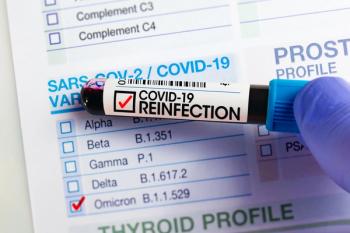
Pharmacists in ACOs, Part 2: Medication Therapy Management and Annual Wellness Visits
To date, medication therapy management and annual wellness visits are the primary services that have demonstrated benefits regarding improvements in health outcomes and cost savings when pharmacists are integrated specifically within an ACO.
A report from the Accountable Care Organization Research Network, Services, and Education (ACORNSEED)
Now that we know the basics of accountable care organizations (ACOs), which were covered in
Q: Let’s break it down, what is MTM?
A: MTM is defined as services intended to optimize therapeutic outcomes for individual patients.3 It describes a broad range of medication-related services provided by pharmacists, such as medication therapy reviews, pharmacotherapy consults, anticoagulation management, and other clinical services.3,4 When properly performed, these services decrease polypharmacy, prevent adverse drug events, increase medication adherence, and identify medication misuse—all cost drivers in the health care system.5 The 5 core aspects of MTM are (1) medication therapy review, (2) a personal medication record, (3) a medication-related action plan, (4) intervention and/or referral, and (5) documentation and follow-up.6 MTM can be performed and completed in person, over the telephone, or using telecommunication technology. At the conclusion of MTM, interventions that are identified are reviewed and resolved by contacting and discussing each problem with the patient’s primary care provider or appropriate specialist. A patient takeaway is also created and provided to the patient with the summary of recommendations and interventions, along with an updated medication list.
Q: What is the role of pharmacists performing MTM within an ACO?
A: Pharmacists are increasingly performing MTM as part of their baseline job responsibilities, in both inpatient and outpatient settings. Examples include (1) clinical pharmacists performing MTM on patients post discharge (on the inpatient or outpatient side during transitions of care), (2) retail pharmacists performing MTM for annual comprehensive medication reviews using claims-based data computer software platforms (eg, OutcomesMTM, Mirixa), (3) inpatient staff pharmacists performing MTM when conducting therapeutic interchanges after reviewing all drug classes within a patient’s chart, and (4) managed care pharmacists performing MTM to decrease health care costs by addressing nonadherence.7-9 Additionally, pharmacists can target high-risk and high-cost medications, such as anticoagulants, antihypertensives, and diabetic medications, along with polypharmacy through MTM, which in turn relieves physicians by freeing their time from these tasks.
ACOs are in the early stages of integrating pharmacists into MTM, providing an idealized opportunity for enhanced patient care, especially in rural communities with few providers. This is easily accomplished because pharmacists are the most accessible health care providers and have the most in-depth knowledge of drug therapy.9
In addition to pharmacists reducing physician work burden, research has shown that pharmacist-led MTM can increase cost savings and improve health outcomes.10-16 MTM also helps reduce duplicative therapies, helps increase adherence, and offers an opportunity to switch to lower cost alternatives, further contributing to the benefits of accountable care. Additionally, by focusing on high-risk patients and complex medication issues, MTM helps avoid physician visits, hospital readmissions, and emergency department visits, providing significant cost savings.17 With pharmacists at the point-of-order verification, interventions can hold prescribers accountable for appropriately prescribing optimal evidence-based therapies and ensuring proper therapy.
In summary, integrating pharmacists in an ACO to perform MTM adherence can increase, outcomes can improve, and health care costs, both direct and indirect, can be reduced. By playing a role as an integral part of the ACO team, pharmacists can follow up on recommendations and interventions at a much higher rate than many other settings. This can help to increase quality of care and coordination between providers.
Q: Next, let’s break down AWVs, what are they?
A: The AWV is a benefit to Medicare beneficiaries as enacted by the Affordable Care Act of 2010. All Medicare beneficiaries are eligible to receive an AWV if they are enrolled in Medicare Part B for at least 12 months and have not received an initial preventive physical examination upon enrollment.18 CMS recognizes the crucial role health care professionals, including pharmacists, play in educating Medicare beneficiaries about, and providing them with, potentially life-saving preventive services and screenings. During an AWV, a health care professional must review a patient’s health risk assessment (HRA), establish a medical/family history, take vital signs, assess cognitive impairment, review risk factors, perform a functional capacity evaluation, conduct a safety analysis, and perform depression and anxiety screenings. Based on the results of these assessments, a written care plan for the patient is established. The goal of AWVs is to provide personalized prevention plan services.18 AWVs are different from annual clinic visits and are not required to be provided by physicians. Therefore, nonphysician licensed health care professionals, including pharmacists, under the direct supervision of a physician, can provide AWVs.19
Q: What is the role of pharmacists performing AWVs within an ACO?
A: AWVs are cost-effective for ACOs and increase their shared savings substantially.20 AWVs also provide a new and important avenue for practicing pharmacists. AWVs can shorten emergency department and hospital stays and reduce chronic disease, medication, and ancillary costs. Additionally, as patients are assigned an HRA, ACOs can identify high-risk patients to manage.20
By performing AWVs, pharmacists can easily and effectively provide high-value services along with other important services, including medication reconciliations, immunizations, health screenings, and pharmacotherapeutic consultations. Pharmacists in ACOs can play an important role in conducting AWVs, considering that a component of these visits is evaluation of a patient’s well-being, along with medication adherence and optimization. In addition, pharmacist-led AWVs give other health care providers more time to focus on more specialty and diagnostic care while pharmacists provide medication-related and preventive services to patients.
A recent study evaluating AWVs conducted by pharmacists in an ACO showed that pharmacists can positively impact clinical and financial outcomes. In this study, pharmacist recommendations, including medication or dosage changes, vaccination administration, laboratory testing, and specialist referrals, had a high acceptance rate among providers and patients. Additionally, pharmacist-led AWVs during the 3-month study period generated a revenue of $22,340.21
The third and final article of this series will discuss how pharmacists can influence accountable care through chronic care management, transitions of care, and disease state management.
This article is published in collaboration with the
Genevieve M. Hale, PharmD, BCPS, is assistant professor of Pharmacy Practice; Tina Joseph, PharmD, BCACP, is assistant professor of Pharmacy Practice; Yesenia Prados, PharmD, is a clinical pharmacist of Pharmacy Practice; Cynthia Moreau, PharmD, is assistant professor of Pharmacy Practice; and Matthew Seamon, PharmD, Esq, is associate professor and chair of Pharmacy Practice. All the authors work at Nova Southeastern University College of Pharmacy and are members of the Accountable Care Organization Research Network, Services, and Education (ACORNSEED).
References
- Brummel A, Lustig A, Westrich K, et al. Best practices: improving patient outcomes and costs in an ACO through comprehensive medication therapy management. J Manag Care Spec Pharm. 2014;20(12):1152-1158.
- Alhossan A, Kennedy A, Leal S. Outcomes of annual wellness visits provided by pharmacists in an accountable care organization associated with a federally qualified health center. Am J Health Syst Pharm. 2016;73(4):225-228. doi: 10.2146/ajhp150343.
- American Pharmacist Association. Medication therapy management in pharmacy practice: core elements of an MTM service model version 2.0. APhA website. pharmacist.com/sites/default/files/files/core_elements_of_an_mtm_practice.pdf. Published March 2008. Accessed August 27, 2016.
- American Pharmacists Association MTM Central. APhA website. pharmacist.com/mtm. Accessed August 27, 2016.
- Pellegrino AN, Martin MT, Tilton JJ, Touchette DR. Medication therapy management services: definitions and outcomes. Drugs. 2009;69(4):393-406. doi: 10.2165/00003495-200969040-00001.
- Centers for Medicare & Medicaid Services. Part D enhanced medication therapy management model fact sheet. CMS website. cms.gov/Newsroom/MediaReleaseDatabase/Fact-sheets/2015-Fact-sheets-items/2015-09-28.html. Published September 28, 2015. Accessed August 27, 2016.
- OutcomesMTM. OutcomesMTM website. outcomesmtm.com. Accessed August 27, 2016.
- Mirixa. Mirixa website. mirixa.com. Accessed August 27, 2016.
- Pharmacists offer MTM services to support ACOs. Managed Healthcare Executive website. managedhealthcareexecutive.modernmedicine.com/managed-healthcare-executive/news/user-defined-tags/pharmacist/pharmacists-offer-mtm-services-suppor. Accessed August 27, 2016.
- Isetts BJ, Schondelmeyer SW, Artz MB, et al. Clinical and economic outcomes of medication therapy management services: the Minnesota experience. J Am Pharm Assoc (2003). 2008;48(2):203-211. doi: 10.1331/JAPhA.2008.07108.
- Cipolle RJ, Strand LM, Morley PC. Pharmaceutical Care Practice: The Patient-Centered Approach to Medication. 3rd ed. New York: McGraw-Hill; 2012.
- Isetts BJ, Brummel AR, de Oliveira DR, Moen DW. Managing drug-related morbidity and mortality in the patient-centered medical home. Med Care. 2012;50(11):997-1001. doi: 10.1097/MLR.0b013e31826ecf9a.
- Isetts BJ. Evaluating effectiveness of the Minnesota medication therapy management care program: final report. Minnesota state website. archive.leg.state.mn.us/docs/2008/mandated/080113.pdf. Submitted December 14, 2007. Accessed August 27, 2016.
- Roughead EE, Barratt JD, Ramsay E, et al. The effectiveness of collaborative medicine reviews in delaying time to next hospitalization for patients with heart failure in the practice setting: results of a cohort study. Circ Heart Fail. 2009;2(5):424-428. doi: 10.1161/CIRCHEARTFAILURE.109.861013.
- Nichol A, Downs G. The pharmacist as physician extender in family medicine office practice. J Am Pharm Assoc (2003). 2006;46(1):77-83.
- Traynor K. Fairview MTM services support accountable care. American Society of Health-System Pharmacists. ASHP website. ashp.org/menu/News/PharmacyNews/NewsArticle.aspx?id=3770. Published September 15, 2012. Accessed August 27, 2016.
- Pharmacists as vital members of accountable care organizations: Academy of Managed Care. AMCP website. amcp.org/ACO.pdf. Updated March 2012. Accessed August 27, 2016.
- CMS. Medicare benefit policy manual, chapter 15, section 285.2:42 CFR 410.32(b)(3)(ii). CMS website. cms.gov/Regulations-and-Guidance/Guidance/Manuals/downloads/bp102c15.pdf. Accessed August 27, 2016.
- Park I, Sutherland SE, Ray L, Wilson CG. Financial implications of pharmacist-led Medicare annual wellness visits. J Am Pharm Assoc. 2014;54(4):435-440. doi: 10.1331/JAPhA.2014.13234.
- Lamakker R. Are you in compliance with Medicare’s annual wellness visit? WellTrackOne website. welltrackone.co/compliance-medicares-annual-wellness-visit. Accessed August 27, 2016.
- Alhossan A, Kennedy A, Leal S. Outcomes of annual wellness visits provided by pharmacists in an accountable care organization associated with a federally qualified health center. Am J Health Syst Pharm. 2016;73(4):225-228. doi: 10.2146/ajhp150343.
Newsletter
Stay informed on drug updates, treatment guidelines, and pharmacy practice trends—subscribe to Pharmacy Times for weekly clinical insights.


















































































































































































































